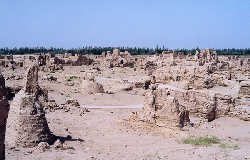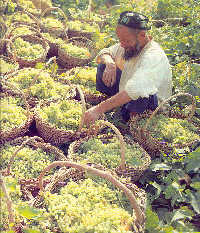| Curiosity > Landscape |
|
|
Turpan: The 'lowest, sweetest, hottest and driest'
Turpan, which means "rich and endowed place" in Turkish, is suited to the
middle of Xijiang. Known as "Gaochang," "Xizhou" or "Huozhou" in historic
records, Turpan has become the political, cultural and economic center in
western China early in the Han
Dynasty (206BC-AD220) more than 2,000 years ago. As a famous town of
military importance, Turpan was built as the capital of the ancient Cheshi
Kingdom. It is also the one of earliest places to open to the outside world.
Since the Tang
Dynasty (618-907), external exchanges with other
countries have taken place. Businessmen, monks and ministers from China, India,
Persia and the Mediterranean gathered and interacted with each other in Turpan,
leaving behind numerous stories and legends. Turpan's distinctive features prevent it from being confused with any other region. Local people have pinpointed the region's four "bests" to present its unique natural conditions, which epitomize Turpan's geological and climatic characteristics.
The Turpan Basin is China's lowest point. With an altitude of more than 4,000
square kilometers here is actually under the sea level, among which more than
2,000 is 100 meters under the sea level. The basin slopes from the north to the
south. The lowest area in the basin is Aiding Lake, located 155 meters below sea
level -- the second-lowest place in the world after the Dead Sea.
|
|||||||
 |


 'The Lowest'
'The Lowest'